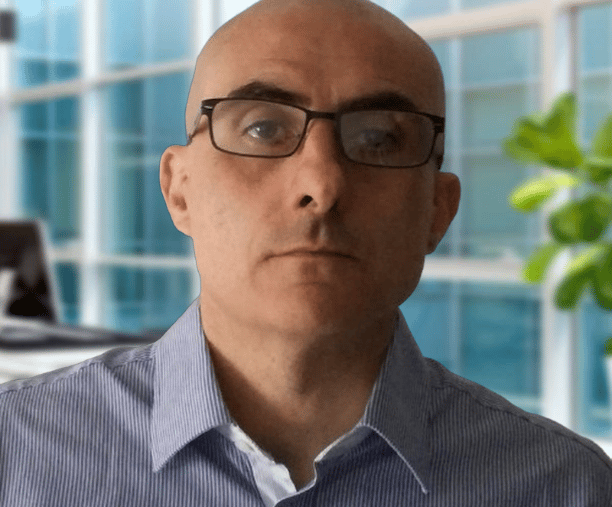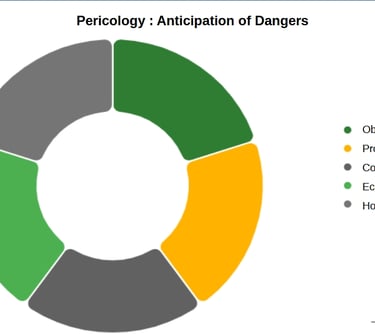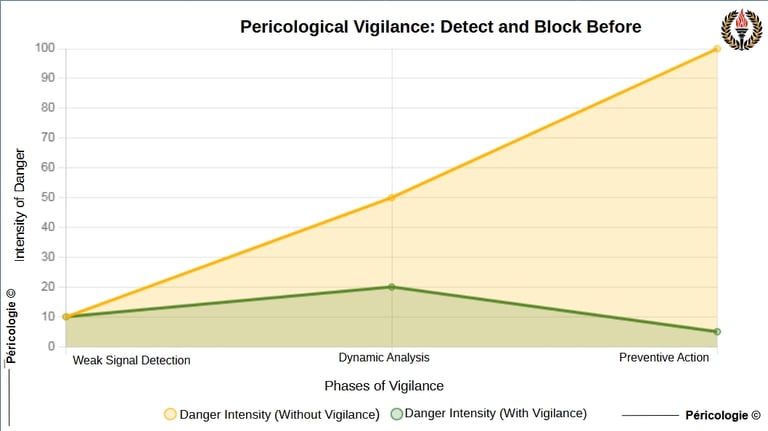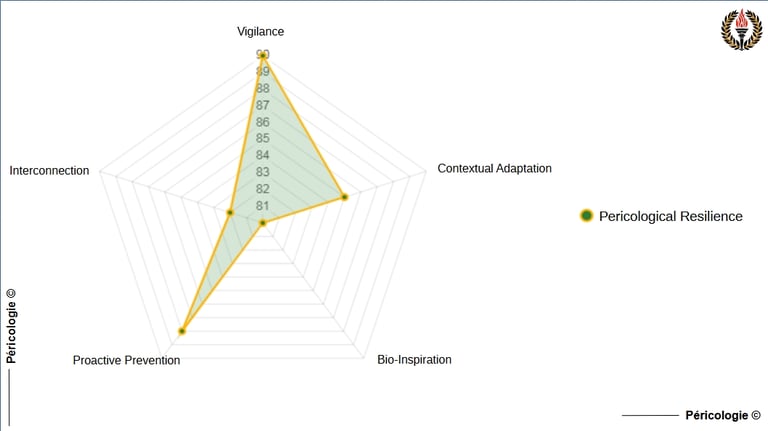The Identity of Pericology
Jean Bourdin
Jean Bourdin is the founder of Pericology , a discipline he created in 2018 to anticipate and prevent systemic perils. He developed this methodical approach by combining rigorous observation, adaptive analysis and targeted action, inspired by the cooperative dynamics of nature. His role has been to structure Pericology around clear principles, identify warning signals, understand their dynamics and intervene before crises, while making it accessible to everyone, from local communities to decision-makers.


Jean Bourdin
Founder / Pericology
Pericology
"Pericology is an applied discipline of anticipation and prevention of systemic perils." Inspired by the cooperative dynamics of nature, it integrates human, technological, and systemic approaches to observe, analyze, and counter threats before they reach a critical threshold. Focused on peripheral anticipation, it translates existing scientific knowledge on collaboration in fauna and flora into practical methodologies, promoting systemic resilience in various contexts (human teams, natural ecosystems, interconnected technological systems). Its slogan, "See before, stop before," embodies proactive vigilance to preserve essential balances in the face of biological, socio-cultural, technological, or systemic perils.


Pericology
Diagram of Pericology
Pericological Example
Context : A rural community relies on a river for agricultural irrigation. Weak signals (subtle declines in flow, observed via local sensors) indicate an imminent risk of drought, which could reach a tipping point (critical water shortage).
Pericological Application : Inspired by the cooperation of ants (redistribution of resources in the event of stress), Pericology mobilizes farmers to observe warning signals (via participatory surveys), analyze dynamics (impact on crops), and take action (distribute water via a bio-inspired quota system).
Etymology
The term "Pericology " derives from two complementary linguistic roots:
Periculum (Latin): means "danger" or "risk", denoting a potential threat to a balance.
Peri (Greek): means "around" or "nearby," suggesting an all-encompassing, peripheral observation of peril dynamics.
Pericological Sources
Pericologist
A "Pericologist" is a practitioner dedicated to the anticipation and prevention of systemic perils. He acts as a proactive sentinel, observing weak and measurable signals, analyzing the dynamics of perils, and implementing concrete actions to counter them before they reach a tipping point. The pericologist relies on bio-inspired approaches, drawn from the cooperative dynamics of nature, and integrates human, technological and systemic perspectives to preserve essential balances in various contexts (human teams, ecosystems, interconnected systems). Unlike a crisis manager, the pericologist focuses on peripheral anticipation, embodying the principle "See first, stop first".


Pericologist
Pericologist Diagram
Pericological Example
Context : In a small coastal town, weak signals indicate a risk of ecological imbalance : an abnormal increase in algae in the harbor waters, coupled with complaints from fishermen about declining catches. These indicators, not yet linked to an obvious crisis, threaten the local ecosystem and the community economy.
Pericological Application : A Pericologist, trained in proactive observation , detects these signals via community monitoring and environmental sensors (Observation). He analyzes the underlying dynamics, identifying a positive loop where industrial discharges amplify algal proliferation (Analyze). Inspired by the self-regulating mechanisms of coral reefs, he proposes immediate action : coordinate local stakeholders (fishermen, authorities, industrialists) to reduce discharges before an ecological tipping point (Act).
Etymology
Periculum (Latin) : "Danger" or "risk", evoking a potential threat to a balance, whether human, environmental or societal.
Peri (Greek) : "Around" or "nearby", implying an all-encompassing and peripheral vigilance to surround the danger without being limited to its surface.
-Logue (from the Greek "lógos") : Meaning "one who studies" or "one who treats/discourses about", as in "ecologist" (study of ecosystems) or "psychologist" (study of the mind).
Pericological Sources
Pericological Vigilance
In Pericology, "Vigilance" refers to a proactive and constant attention paid to the detection of weak and measurable signals of perils, whether biological, socio-cultural, technological or systemic. It embodies the state of peripheral alert allowing us to anticipate risk dynamics before they reach a tipping point. Inspired by natural dynamics, pericological vigilance is based on methodical and contextual observation, combining human intuition and technological tools to identify emerging or invisible perils. It is distinguished by its collective and adaptive nature, mobilizing local actors to preserve essential balances without waiting for obvious signals.


Pericological Vigilance
Diagram of pericological vigilance
Pericological example
Context : In a coastal community at risk of accelerated erosion, weak signals (e.g., subtle increases in water levels measured by sensors) indicate an emerging peril related to soil instability.
Pericological Application : A pericologist applies Vigilance by deploying a network of bio-inspired sensors (mimicking the sensitivity of corals to marine variations) to monitor water levels and dune stability in real time. By detecting abnormal erosion (weak signal), he mobilizes local stakeholders to reinforce natural barriers (e.g., planting stabilizing plants) before the diffuse peril becomes a crisis (coastal collapse). This proactive anticipation illustrates the slogan "See before, steer before."
Etymology
The term vigilance comes from the Latin vigilantia , derived from vigilans (present participle of vigilare), meaning "to be awake, watchful, attentive." The word vigilare is related to vigere ("to be vigorous, to prosper"), suggesting an active energy in observation.
Pericological : From the Latin periculum ("danger, risk") and the Greek peri ("around").
Pericological Sources
Pericological Resilience
In Pericology, "Resilience" refers to the capacity of a system, whether human, biological, technological or systemic, to preserve or restore an essential balance in the face of perils, by anticipating and adapting to disturbances before they reach a tipping point. Unlike classical resilience (e.g., return to the initial state post-crisis, as in ISO 31000 risk management), pericological resilience is proactive, inspired by the collaborative dynamics of nature. It mobilizes bio-inspired tools, such as the self-management observed in animal colonies, to maintain stability in the face of emerging, invisible or diffuse perils.


Pericological Resilience
Diagram of pericological resilience
Pericological Example
Context : A small town dependent on a local electricity grid vulnerable to overloads (emerging systemic peril).
Pericological Application : Inspired by ant colonies redistributing resources in the face of a disruption, Pericology proposes a system of intelligent sensors detecting weak overload signals (e.g., consumption peaks). An automatic redistribution of energy to local micro-grids is implemented, preserving the network balance before a critical failure.
Etymology
The term resilience comes from the Latin resilire , a compound of re- ("back") and salire ("to jump"), literally meaning "to bounce back" or "to go back."
Pericological : From the Latin periculum ("danger, risk") and the Greek peri ("around").
Pericological Sources
Pericological Flexibility
In Pericology, "Flexibility" refers to the ability of a system, whether human, biological or technological, to dynamically adjust to evolving contexts and danger signals, while maintaining its functional balance. It is manifested by rapid and contextual adaptation to the dynamics of dangers, without depending on prefabricated solutions. Unlike simple elasticity (return to the initial state), pericological flexibility integrates a proactive reorganization of resources and strategies to anticipate critical thresholds and avoid tipping points.


Pericological Flexibility
Diagram of pericological flexibility
Pericological Example
Context : In a coastal community facing recurrent flooding (systemic peril), traditional solutions (fixed levees) fail in the face of changing climate conditions (varying storm intensity). Weak signals (increasing micro-floods) indicate a potential tipping point towards major floods.
Pericological Application : Flexibility, as a contextual adjustment capacity, guides the pericological observer to detect local variations (e.g.: rising tides via sensors). The analyzer models the dynamics (positive loop : erosion amplifying the risk). The action consists of deploying bio-inspired modular barriers (inspired by mangroves, which adapt to flows), adjusted in real time according to the intensity of the tides.
Etymology
The term flexibility derives from the Latin flexibilitas , from flexibilis (“foldable, adaptable”), itself formed from the verb flectere (“to bend, to curve”).
Pericological : From the Latin periculum ("danger, risk") and the Greek peri ("around").
Pericological Sources
https://www.clionautes.org/risques-quotidien-vulnerabilite-resilience-adaptation.html
https://shs.cairn.info/revue-questions-de-management-2023-5-page-148?lang=fr
https://www.afd.fr/fr/actualites/anticiper-subir-adaptation-catastrophes-naturelles-guadeloupe
https://shs.cairn.info/revue-francaise-de-gestion-2006-3-page-35?lang=fr
https://anticiper.org/resilience/capacite-d-adaptation-facteur-resilience-important.php
For enthusiasts
Our links
Message
© 2025. All rights reserved. By Pericology
